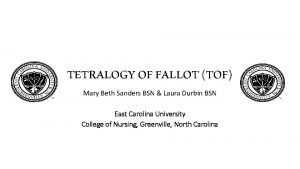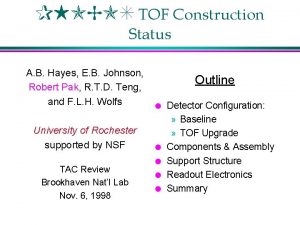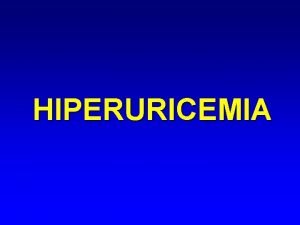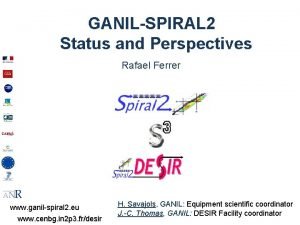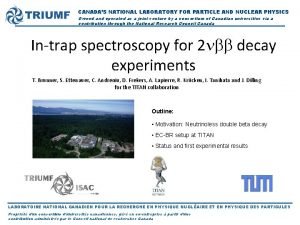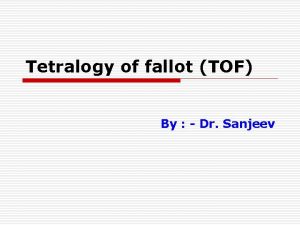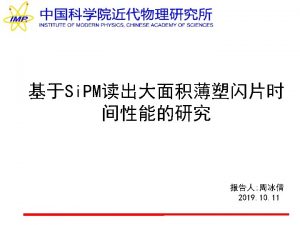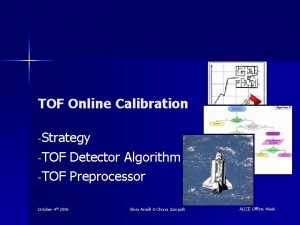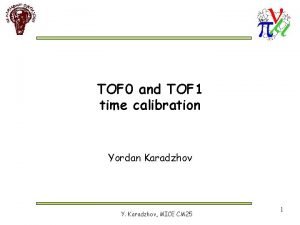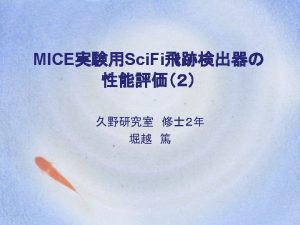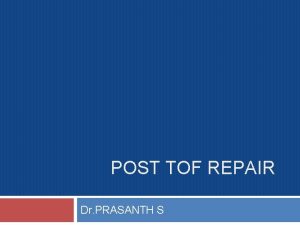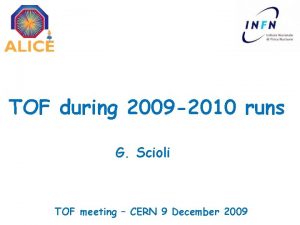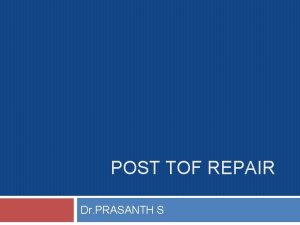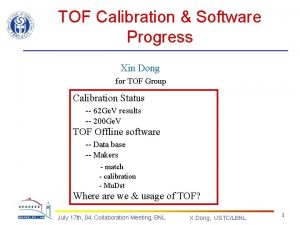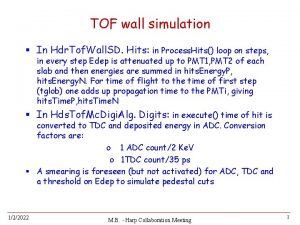Statusplans for KLONE clustering and TOF analysis Status











- Slides: 11

Status/plans for KLONE clustering and TOF analysis … Ø Ø Ø Status of calibrated files. . Status of clustering Trigger timing + t 0 neutrons Status of time. . rephasing. . plans. . M. Martini + Stefano Miscetti LNF INFN 29/1/2007 1

Calibrated files by. /klone_read…� It is now available a fully debugged and working version of. /klone_read which creates file Klone_c_runnr_x. hbook, Where c stays for calibrated and x is the file number Increased each 100 k events. We have now fixed: 0) Pedestal bufferse. They are now correctly managed and use 1) Swap of channels inserted in Get. Calo are now used and applied by. /klone_read (routine getcele) 2) The calorimeter output is now in Me. V and ns (still 50 ps/count) Production of “chosen” files can start. 29/1/2007 2

Status of clustering� We are proud to say that, after one week of debugging, we have dropped makecluster. f ---> there were from 2 to 10 % of cases of wrong clusters built. Solution: use the KLOE clustering. Few lines but well working. Makecluster_v 3. f will be from now on the default one. We have also add the list of cells belonging to the cluster! An easy example of anadriver has been developed. Users can start looping on calibrated files starting from this Example: 29/1/2007 3

Anadriver Integer function ANADRIVER (Nrun, Trig. Flag, T 0 fix, Tmax, Plamax) Where: - trigflag 0/1 means apply or not the trigger cut - t 0 fix 0/1 means apply or not the t 0 rephasing - tmax is a cut in ns on the max time spectra of cells used for clustering - plamax is a cut on the max plane number of cells used for clustering 29/1/2007 4

Anadriver (II) Integer function ANADRIVER (Nrun, Trig. Flag, T 0 fix, Tmax, Plamax) - A part from QA, QB, TA, TB for the cluster list we bring back: Nclu # Number of cluster Celle_clu # of cells/cluster T_clu mean values X_clu Z_clu cellinto # list of cells belonging to the cluster For each cell we have an identifier which is cell. Id cellid = icol + 3*(ipla-1) And a simple function to retrieve the icol, ipla information Istat = celleupk(cellid, icol, ipla) 29/1/2007 5

Trigger cut - We have filled t 0 spectra for cells and for tdc 41 (Time of Sum. A*Sum. B) - We have fit the trigger time with p 0+g and cut +/- 3 sigma around the gaussian peak. - T 0 spectra have been obtained before and after the trigger cut - Under investigation also the t 0 -spectra from clustering using the cell with the fastest time in the cluster. A file triggercut. txt has to be created on the whole sample by running the Kumac on the selected files: Nrun 1 T 0 min T 0 max Nrun 2 T 0 min T 0 max In the code the calls istat = trigger_cut(Nrun, Tdc 41, Lunin) if( istat. eq. 0) return Will eliminate the bad peaks�� 29/1/2007 6

T 0 spectra The time spectra have been fit with: - A) p 1+g or - B) g only with a recursive search of the peak Method A not perfectly stable Method B from Simona seems to work much better It is interesting now start comparing with MC the start of the spectra to understand how to rephase them in An automatic and “reasonable” way. We just show in the following the fit done after the Application of the Trigger cuts. 29/1/2007 7

T 0 spectra 29/1/2007 8

T 0 spectra 29/1/2007 9

T 0 spectra 29/1/2007 10

T 0 spectra 29/1/2007 11
